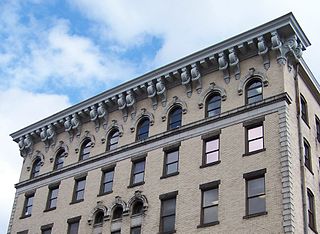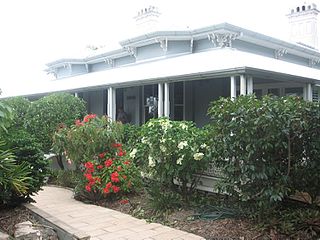| Goldsbrough Mort Woolstore | |
|---|---|
Goldsbrough Mort & Co Wool Store, 2010 | |
| Location | 88 Macquarie Street, Teneriffe, City of Brisbane, Queensland, Australia |
| Coordinates | 27°27′30″S153°02′59″E / 27.4584°S 153.0496°E Coordinates: 27°27′30″S153°02′59″E / 27.4584°S 153.0496°E |
| Design period | 1919 - 1930s (interwar period) |
| Built | c. 1933 |
| Built for | Goldsbrough Mort & Co |
| Official name: Goldsbrough Mort Woolstore | |
| Type | state heritage (built) |
| Designated | 21 October 1992 |
| Reference no. | 600323 |
| Significant period | 1930s (fabric) c. 1933-1980s (historical use) |
| Builders | Stuart Brothers (Sydney) |
Goldsbrough Mort Woolstore is a heritage-listed warehouse at 88 Macquarie Street, Teneriffe, City of Brisbane, Queensland, Australia. It was built c. 1933 by Stuart Brothers (Sydney). It was added to the Queensland Heritage Register on 21 October 1992. [1]

A warehouse is a building for storing goods. Warehouses are used by manufacturers, importers, exporters, wholesalers, transport businesses, customs, etc. They are usually large plain buildings in industrial parks on the outskirts of cities, towns or villages.

Teneriffe is a historic riverside inner suburb of the City of Brisbane, Queensland, Australia. It is located 2.5 kilometres (1.6 mi) north-east of the CBD, and borders Fortitude Valley in its north-west, Newstead in the north and New Farm in its West and South.

The City of Brisbane is a local government area that has jurisdiction over the inner portion of the metropolitan area of Brisbane, the capital of Queensland, Australia. Brisbane is located in the county of Stanley and is the largest city followed by Ipswich with bounds in part of the county. Unlike LGAs in the other mainland state capitals, which are generally responsible only for the central business districts and inner neighbourhoods of those cities, the City of Brisbane administers a significant portion of the Brisbane metropolitan area, serving almost half of the population of the Brisbane Greater Capital City Statistical Area. As such, it has a larger population than any other local government area in Australia. The City of Brisbane was the first Australian LGA to reach a population of more than one million. Its population is roughly equivalent to the populations of Tasmania, the Australian Capital Territory and the Northern Territory combined. In 2016–2017, the council administers a budget of over $3 billion, by far the largest budget of any LGA in Australia.


























